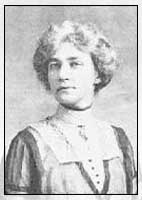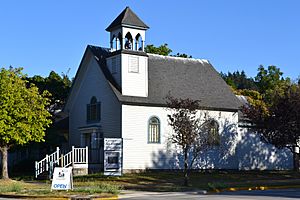Maude Kerns facts for kids
Quick facts for kids
Maude Irvine Kerns
|
|
|---|---|
 |
|
| Born | August 1, 1876 |
| Died | August 19, 1965 (aged 89) Eugene, Oregon, U.S.
|
| Nationality | American |
| Alma mater | University of Oregon, San Francisco Art Institute Columbia University |
| Movement | Avant-garde |
Maude Irvine Kerns (born August 1, 1876 – died August 19, 1965) was an American artist and art teacher. She was famous for her unique and modern paintings, often called avant-garde or abstract art. Her artwork was shown in important places like the Solomon R. Guggenheim Museum and the National Gallery of Art.
Maude Kerns also taught art for many years. She worked at the University of Oregon and in high schools in Corvallis and Seattle. She helped many students learn about art until she passed away in 1965.
Early Life and Schooling
Maude Kerns was born in 1876 in Portland, Oregon. Her parents had moved to Oregon in 1852. Her mother was a school teacher. Maude had an older sister, Edith, and two younger brothers, LeRoy and Harold. In 1884, her family moved to Eugene.
In 1891, Maude started high school at a special school connected to the University of Oregon. She graduated from the University of Oregon in 1899 with a Bachelor of Arts degree. After that, she went to the Mark Hopkins Institute (now the San Francisco Art Institute) in San Francisco in 1900.
She moved to New York City in 1904 to study at Columbia University Teacher College. There, she earned degrees in Fine Arts and Art Education. One of her teachers, Arthur Wesley Dow, thought she was a very dignified and strong-minded person.
Art Career and Teaching

Before moving to New York, Maude Kerns taught art in different towns in Oregon. After getting her degree from Columbia, she taught art in Seattle high schools for 14 years. She also studied with famous artists like William Merritt Chase.
Maude traveled through Asia and Europe to see art from around the world. She was inspired by artists like Wassily Kandinsky, Piet Mondrian, and Paul Klee, who were part of the avant-garde art movement. She also learned from the well-known art teacher Hans Hofmann.
Later, Kerns returned to teach at the University of Oregon in Eugene. From 1921 to 1947, she led the art education program. She retired in the 1940s. Sadly, many of her early artworks were lost in a fire at the art school.
Abstract Art and Influence
From the 1930s to the 1950s, Maude Kerns became known for her abstract paintings. This style was sometimes called "non-objective" art. She was famous for her modern landscapes. Her work was shown at the Museum of Non-Objective Painting in New York.
Maude Kerns was a spiritual person. She believed that art could express spiritual ideas, much like Wassily Kandinsky. She was also influenced by Asian art. She was a very creative teacher. For example, she would have her students paint while listening to music to help them try new styles.
Her paintings were highly valued by Hilla von Rebay, who was a main advisor to Solomon R. Guggenheim. Rebay bought many of Kerns' paintings for Guggenheim's museum, which is now called the Solomon R. Guggenheim Museum in New York City.
Legacy
Maude Kerns passed away in 1965. She was a major supporter and founder of The Eugene Art Center, which started in 1950. After her death, the center was renamed The Maude Kerns Art Center in her honor. Today, the art center continues to promote modern art, including paintings, mixed media, and ceramics.

